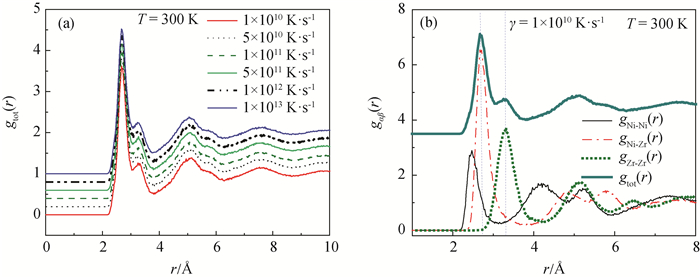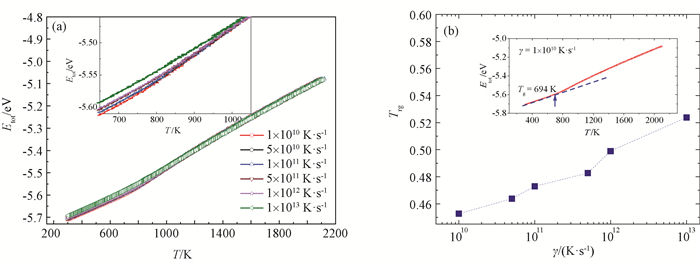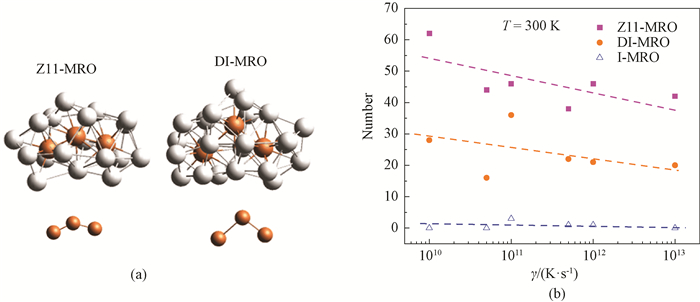计算物理 ›› 2024, Vol. 41 ›› Issue (4): 494-502.DOI: 10.19596/j.cnki.1001-246x.8742
祁青华1,2( ), 文大东2,*(
), 文大东2,*( ), 陈贝1, 高明2, 易洲2, 邓永和2, 邓科1, 彭平3
), 陈贝1, 高明2, 易洲2, 邓永和2, 邓科1, 彭平3
收稿日期:2023-04-10
出版日期:2024-07-25
发布日期:2024-08-24
通讯作者:
文大东
作者简介:祁青华, 男, 硕士研究生, 主要从事非晶合金微结构分析, E-mail: qqh1466961467@163.com
基金资助:
Qinghua QI1,2( ), Dadong WEN2,*(
), Dadong WEN2,*( ), Bei CHEN1, Ming GAO2, Zhou YI2, Yonghe DENG2, Ke DENG1, Ping PENG3
), Bei CHEN1, Ming GAO2, Zhou YI2, Yonghe DENG2, Ke DENG1, Ping PENG3
Received:2023-04-10
Online:2024-07-25
Published:2024-08-24
Contact:
Dadong WEN
摘要:
采用分子动力学方法, 模拟研究6个不同冷速下液态Ni50Zr50合金的快速凝固过程, 用双体分布函数、原子团类型指数、遗传跟踪等方法对快凝合金的微结构特征与演化特性进行表征和分析。结果表明: Ni50Zr50玻璃合金中数目最多的原子组态是Z11 Kasper团簇, 而非二十面体。快凝合金中的特征团簇趋向于聚合在一起形成中程序, 其数目随冷速的降低而增加。基本团簇的结构遗传均起始于Tm~Tg的过冷液相区, 其中Z11 Kasper团簇在Tg以上的附近温区具有最高阶段遗传分数。提高冷速有利于过冷液相区中基本团簇的阶段遗传分数增加和遗传的起始温度升高。冷速诱导的Ni50Zr50合金玻璃形成能力(GFA)的提高可以归因于特征团簇(如Z11 Kasper团簇)遗传能力的增强。
中图分类号:
祁青华, 文大东, 陈贝, 高明, 易洲, 邓永和, 邓科, 彭平. 冷速对快凝Ni50Zr50合金团簇结构遗传与演化特性的影响[J]. 计算物理, 2024, 41(4): 494-502.
Qinghua QI, Dadong WEN, Bei CHEN, Ming GAO, Zhou YI, Yonghe DENG, Ke DENG, Ping PENG. Heredity and Evolution of Cluster in Rapid Solidification of Liquid Ni50Zr50 Alloy under Different Cooling Rates[J]. Chinese Journal of Computational Physics, 2024, 41(4): 494-502.

图1 不同冷速下,300 K时快凝Ni50Zr50合金的双体分布函数(a)总双体分布函数gtot(r); (b)偏双体分布函数gαβ(r)
Fig.1 Pair distribution functions (PDFs) of rapidly solidified Ni50Zr50 alloy at 300 K for various cooling rates (a) total PDF gtot(r); (b) partial PDF gαβ(r)
| Data sources | Measuring method | (R±0.02)/Å | |||
| Ni-Ni | Ni-Zr | Zr-Zr | Ni-Zr(tot) | ||
| This work | MD | 2.65 | 2.79 | 3.35 | 2.79 |
| Ref.[ | MD | 2.64 | 2.77 | 3.34 | 2.78 |
| Ref.[ | EXAFS | 2.63 | 2.62 | 3.31 | |
| Ref.[ | ND | 2.63 | 2.73 | 3.32 | |
表1 Ni50Zr50玻璃合金中原子间距的模拟结果与实验值的比较(T=300 K)(R: 原子间距离,ND:中子衍射,EXAFS:扩展X射线吸收精细结构)
Table 1 Comparison between simulated results and experimental values of interatomic distance in Ni50Zr50 glassy alloy (T=300 K) (R, ND, and EXAFS in Table 1 denoetes interatomic distance, neutron diffraction, and extended X-ray absorption fine structure, respectively.)
| Data sources | Measuring method | (R±0.02)/Å | |||
| Ni-Ni | Ni-Zr | Zr-Zr | Ni-Zr(tot) | ||
| This work | MD | 2.65 | 2.79 | 3.35 | 2.79 |
| Ref.[ | MD | 2.64 | 2.77 | 3.34 | 2.78 |
| Ref.[ | EXAFS | 2.63 | 2.62 | 3.31 | |
| Ref.[ | ND | 2.63 | 2.73 | 3.32 | |

图2 不同冷速下快凝Ni50Zr50合金的(a) 平均原子总能量Etot随温度T的变化;(内插图是Etot-T曲线在650~1 050 K温度区间的放大。)(b) 约化玻璃转变温度Trg与冷速γ的关系(内插图是采用外推方法估测玻璃转变温度Tg的示意图。)
Fig.2 For rapidly solidified Ni50Zr50 alloy at different cooling rates: (a) Variation of total energy per atom Etot with T(The inner illustration shows the amplification of the Etot -T curve in the temperature range of 650-1050 K.) and (b) variation of reduced glass transition temperature Trg with cooling rate γ (The inner illustration is the glass transition temperature Tg estimated by extrapolation.)

图5 快凝Ni50Zr50合金中的中程有序(MRO) (a)MRO结构;(b)MRO数目与冷速的关系
Fig.5 Medium-range orders (MROs) in rapidly solidified Ni50Zr50 alloys (a) structure of typical MROs; (b)number of MROs with different cooling rates

图6 液态Ni50Zr50合金快凝过程中一个Z11-MRO的遗传与长大(a)T=860 K,N=2,n=18; (b)T=850 K,N=3,n=23;(c)T=730 K,N=6,n=38; (d) T=720 K,N=6,n=42; (e) T=600 K,N=6,n=35; (f) T=300 K,N=6,n=37 (紫色和白色球分别表示保持相对稳定中心原子和近邻原子,红色和青色球分别表示新增的中心原子和近邻原子;T表示温度、N表示中心原子数、n表示团簇原子总数。)
Fig.6 The heredity and growth of a Z11-MRO during the rapid solidification process of liquid Ni50Zr50 alloy (Purple and white balls represent relatively stable central and neighboring atoms, while red and cyan balls represent newly added central and neighboring atoms, respectively; T represents temperature, N represents number of central atoms, and n represents total number of cluster atoms.) (a)T=860 K, N=2, n=18; (b)T=850 K, N=3, n=23; (c)T=730 K, N=6, n=38; (d) T=720 K, N=6, n=42; (e) T=600 K, N=6, n=35; (f) T=300 K, N=6, n=37

图7 快凝Ni50Zr50合金中典型基本原子团簇的阶段遗传分数f随温度T的演化(a) γ=1×1011 K·s-1,不同团簇的f;(b)不同冷速,(11 2/1441 8/1551 1/1661)团簇的f;(c)不同冷速,(12 2/1441 8/1551 2/1661)团簇的f;(d)不同冷速,(12 12/1551)团簇的f
Fig.7 Fraction f of staged heredity for typical basic clusters in rapidly solidified Ni50Zr50 alloys with temperature (a) f of different clusters at γ=1×1011 K·s-1; (b) f of (11 2/1441 8/1551 1/1661) clusters at different γ; (c) f of (11 2/1441 8/1551 2/1661) clusters at different γ and (d) f of (12 12/1551) cluster at different γ
| 1 | 汪卫华. 非晶态物质的本质和特性[J]. 物理学进展, 2013, 33 (5): 177- 351. |
| 2 | 汪卫华. 金属玻璃研究简史[J]. 物理, 2011, 40 (11): 701- 709. |
| 3 |
汪卫华. 金属玻璃的过去、现在和未来[J]. 自然杂志, 2022, 44 (3): 173- 181.
DOI |
| 4 |
DU Jinglian , WEN Bin , MELNIK R , et al. First-principles studies on structural, mechanical, thermodynamic and electronic properties of Ni-Zr intermetallic compounds[J]. Intermetallics, 2014, 54, 110- 119.
DOI |
| 5 |
KIM H K , LEE M , LEE K R , et al. How can a minor element added to a binary amorphous alloy simultaneously improve the plasticity and glass-forming ability?[J]. Acta Materialia, 2013, 61 (17): 6597- 6608.
DOI |
| 6 |
YU C Y , LIU X J , ZHENG G P , et al. Atomistic approach to predict the glass-forming ability in Zr-Cu-Al ternary metallic glasses[J]. Journal of Alloys and Compounds, 2015, 627, 48- 53.
DOI |
| 7 |
管立, 吴爱玲, 张晓茹. 液态Au和Ag冷却过程的分子动力学模拟[J]. 计算物理, 2001, 18 (4): 356- 359.
DOI |
| 8 |
XING L Q , SHEN Y T , KELTON K F . Precipitation of an icosahedrally symmetric ordered phase in Zr-Ti-Cu-Ni-Al metallic glasses[J]. Applied Physics Letters, 2002, 81 (18): 3371- 3373.
DOI |
| 9 |
WESSELS V , GANGOPADHYAY A K , SAHU K K , et al. Rapid chemical and topological ordering in supercooled liquid Cu46Zr54[J]. Physical Review B, 2011, 83 (9): 094116.
DOI |
| 10 |
WEN D D , PENG P , JIANG Y Q , et al. The effect of cooling rates on hereditary characteristics of icosahedral clusters in rapid solidification of liquid Cu56Zr44 alloys[J]. Journal of Non-crystalline Solids, 2014, 388, 75- 85.
DOI |
| 11 |
ABE T , SHIMONO M , ODE M , et al. Estimation of the glass forming ability of the Ni-Zr and the Cu-Zr alloys[J]. Journal of Alloys and Compounds, 2007, 434-435, 152- 155.
DOI |
| 12 |
GHAEMI M , TAVAKOLI R , FOROUGHI A . Comparing short-range and medium-range ordering in CuZr and NiZr metallic glasses-correlation between structure and glass form ability[J]. Journal of Non-Crystalline Solids, 2018, 499, 227- 236.
DOI |
| 13 |
ZHANG Pei , MALDONIS J J , BESSER M F , et al. Medium-range structure and glass forming ability in Zr-Cu-Al bulk metallic glasses[J]. Acta Materialia, 2016, 109, 103- 114.
DOI |
| 14 |
KLUMOV B A , RYLTSEV R E , CHTCHELKATCHEV N M . Polytetrahedral structure and glass-forming ability of simulated Ni-Zr alloys[J]. The Journal of Chemical Physics, 2018, 149 (13): 134501.
DOI |
| 15 |
WANG Feilong , YIN Dawei , LV Jingwang , et al. Effect of cooling rate on fluidity and glass-forming ability of Zr-based amorphous alloys using different molds[J]. Journal of Materials Processing Technology, 2021, 292, 117051.
DOI |
| 16 | 周边, 杨亮. 分子动力学模拟冷却速率对非晶合金结构与变形行为的影响[J]. 物理学报, 2020, 69 (11): 246- 254. |
| 17 |
CHENG Y Q , MA E . Indicators of internal structural states for metallic glasses: Local order, free volume, and configurational potential energy[J]. Applied Physics Letters, 2008, 93 (5): 051910.
DOI |
| 18 |
ZHONG Li , WANG Jiangwei , SHENG Hongwei , et al. Formation of monatomic metallic glasses through ultrafast liquid quenching[J]. Nature, 2014, 512 (7513): 177- 180.
DOI |
| 19 |
TIAN Zean , LIU Rangsu , DONG Kejun , et al. A new method for analyzing the local structures of disordered systems[J]. Europhysics Letters, 2011, 96 (3): 36001.
DOI |
| 20 |
HONEYCUTT J D , ANDERSEN H C . Molecular dynamics study of melting and freezing of small Lennard-Jones clusters[J]. Journal of Physical Chemistry, 1987, 91 (19): 4950- 4963.
DOI |
| 21 | 邓永和, 文大东, 彭超, 等. 二十面体团簇的遗传: 一个与快凝Cu56Zr44合金玻璃形成能力有关的动力学参数[J]. 物理学报, 2016, 65 (6): 270- 279. |
| 22 |
PLIMPTON S . Fast parallel algorithms for short-range molecular dynamics[J]. Journal of Computational Physics, 1995, 117 (1): 1- 19.
DOI |
| 23 |
侯兆阳, 牛媛, 肖启鑫, 等. Al纳米线不同晶向力学行为和变形机制的模拟[J]. 计算物理, 2022, 39 (3): 341- 351.
DOI |
| 24 | CHOW K H , FERGUSON D M . Isothermal-isobaric molecular dynamics simulations with Monte Carlo volume sampling[J]. Computer Physics Communications, 1995, 91 (1/3): 283- 289. |
| 25 |
SHENG H W , KRAMER M J , CADIEN A , et al. Highly optimized embedded-atom-method potentials for fourteen fcc metals[J]. Physical Review B, 2011, 83 (13): 134118.
DOI |
| 26 | 张海燕, 殷新春. 简单金属固液界面固化过程生长机制的分子动力学研究[J]. 计算物理, 2019, 36 (1): 80- 88. |
| 27 |
王国华, 崔雅茹, 杨泽, 等. FexO-SiO2-CaO-MgO- "NiO" 系镍渣势函数及分子动力学模拟[J]. 计算物理, 2021, 38 (2): 215- 223.
DOI |
| 28 |
KOBOLD R , KOLBE M , HORNFECK W , et al. Nucleation study for an undercooled melt of intermetallic NiZr[J]. The Journal of Chemical Physics, 2018, 148 (11): 114502.
DOI |
| 29 |
ZHANG Yue , MATTERN N , ECKERT J . Study of direct relationship between atomic structures and glass forming abilities of Cu100-xZrx (0 < x < 10) liquids by molecular dynamics simulations[J]. Journal of Applied Physics, 2012, 111 (5): 053520.
DOI |
| 30 |
LU Bf , KONG Lt , LAWS K J , et al. EXAFS and molecular dynamics simulation studies of Cu-Zr metallic glass: Short-to-medium range order and glass forming ability[J]. Materials Characterization, 2018, 141, 41- 48.
DOI |
| 31 | 高明, 邓永和, 文大东, 等. 快凝Pd82Si18合金原子团簇的演化特性及遗传机制[J]. 物理学报, 2020, 69 (4): 199- 207. |
| 32 |
WEN T Q , TANG L , SUN Y , et al. Crystal genes in a marginal glass-forming system of Ni50Zr50[J]. Physical Chemistry Chemical Physics, 2017, 19, 30429- 30438.
DOI |
| 33 |
LIU Xj , HUI Xd , CHEN Gl , et al. Local atomic structures in Zr-Ni metallic glasses[J]. Physics Letters a, 2009, 373 (29): 2488- 2493.
DOI |
| 34 | SUZUKI K , HAYASHI N , TOMIZUKA Y , et al. Hydrogen atom environments in a hydrogenated ZrNi glass[J]. Journal of Non-crystalline Solids, 1984, 61/62 Part 1, 637- 642. |
| 35 | 文大东, 邓永和, 戴雄英, 等. 钽过冷液体等温晶化的原子层面机制[J]. 物理学报, 2020, 69 (19): 238- 246. |
| 36 |
TURNBULL D . Under what conditions can a glass be formed?[J]. Contemporary Physics, 1969, 10 (5): 473- 488.
DOI |
| 37 |
KAO Suwen , HWANG C C , CHIN T S . Simulation of reduced glass transition temperature of Cu-Zr alloys by molecular dynamics[J]. Journal of Applied Physics, 2009, 105 (6): 064913.
DOI |
| 38 |
HUANG Mingjun , YUE Kan , WANG Jing , et al. Frank-Kasper and related quasicrystal spherical phases in macromolecules[J]. Science China Chemistry, 2018, 61 (1): 33- 45.
DOI |
| 39 | MATTERN N , JÓVÁRI P , KABAN I , et al. Short-range order of Cu-Zr metallic glasses[J]. Journal of Alloys and Compounds, 2009, 485 (1/2): 163- 169. |
| 40 |
LI F , LIU Xj , LU Zp . Atomic structural evolution during glass formation of a Cu-Zr binary metallic glass[J]. Computational Materials Science, 2014, 85, 147- 153.
DOI |
| 41 |
WEEKS W P , FLORES K M . Using characteristic structural motifs in metallic liquids to predict glass forming ability[J]. Intermetallics, 2022, 145, 107560.
DOI |
| [1] | 许铋立, 景昭, 刘骁, 代波, 姬广富, 张魁宝, 葛妮娜. 硅改性酚醛树脂物理性能的分子动力学模拟[J]. 计算物理, 2024, 41(3): 345-356. |
| [2] | 韩文敏, 戴耀东, 姚初清, 田家祥, 蒋丹枫, 周一帆. 遗传算法在中子-γ混合辐射场屏蔽材料优化设计中的应用[J]. 计算物理, 2024, 41(3): 357-366. |
| [3] | 李勤, 张敏, 许莹. 基于混合算法的P-SV波叠前反演[J]. 计算物理, 2024, 41(3): 380-391. |
| [4] | 温伯尧, 高根英, 路熙, 关松涛, 骆政园, 白博峰. 球状胶束中表面活性剂脱附的离子调控机制[J]. 计算物理, 2024, 41(2): 193-202. |
| [5] | 高旭东, 孙淑义, 魏雯静, 李公平. 金红石TiO2辐照损伤模拟研究[J]. 计算物理, 2024, 41(2): 214-221. |
| [6] | 李禹, 刘慧卿, 冯亚斌, 东晓虎, 王庆, 张波. 典型表活剂与稠油在蒙脱石表面吸附行为的分子动力学模拟[J]. 计算物理, 2023, 40(5): 583-596. |
| [7] | 韦昭召, 刘凯, 李会军. NiAl合金纳米线弯曲形变行为的分子动力学模拟[J]. 计算物理, 2023, 40(4): 425-435. |
| [8] | 侯兆阳, 牛媛, 肖启鑫, 王真, 邓庆田. Al纳米线不同晶向力学行为和变形机制的模拟[J]. 计算物理, 2022, 39(3): 341-351. |
| [9] | 王晓慧, 张平. 高压下FCC相金属氢结构稳定性和非谐效应的理论研究[J]. 计算物理, 2022, 39(2): 159-164. |
| [10] | 阿湖宝, 杨志兵, 胡冉, 陈益峰. 纳米尺度下毛细流动的分子动力学模拟[J]. 计算物理, 2021, 38(5): 603-611. |
| [11] | 屠丽娟, 周恩泽, 吴雪飞, 杨琪, 丁雪峰. 基于流量测点的热网变动阻力系数优化辨识[J]. 计算物理, 2021, 38(4): 498-504. |
| [12] | 王国华, 崔雅茹, 杨泽, 李小明, 汤宏亮, 杨树峰. FexO-SiO2-CaO-MgO-“NiO”系镍渣势函数及分子动力学模拟[J]. 计算物理, 2021, 38(2): 215-223. |
| [13] | 王雪梅, 董斌, 朱子亮, 杨俊升. 聚合物分子与官能化纳米管相互作用及扩散特性的分子动力学模拟[J]. 计算物理, 2020, 37(5): 589-594. |
| [14] | 和二斌, 罗志荣, 朱留华. 肌红蛋白力致去折叠的全原子分析[J]. 计算物理, 2020, 37(2): 205-211. |
| [15] | 周璐, 马红和. 超临界水中硫酸钠结晶动力学的分子动力学模拟[J]. 计算物理, 2020, 37(2): 212-220. |
| 阅读次数 | ||||||
|
全文 |
|
|||||
|
摘要 |
|
|||||
版权所有 © 《计算物理》编辑部
地址:北京市海淀区丰豪东路2号 邮编:100094 E-mail:jswl@iapcm.ac.cn
本系统由北京玛格泰克科技发展有限公司设计开发
